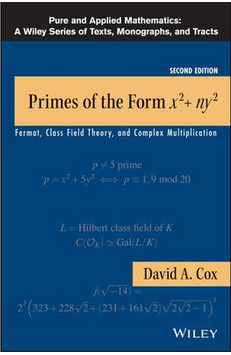
Primes of the Form X2+ny2 : Fermat, Class Field Theory, and Complex Multiplication
[BOOK DESCRIPTION]
An exciting approach to the history and mathematics of number theory "...the author's style is totally lucid and very easy to read ...the result is indeed a wonderful story." -Mathematical Reviews Written in a unique and accessible style for readers of varied mathematical backgrounds, the Second Edition of Primes of the Form p = x2+ ny2 details the history behind how Pierre de Fermat's work ultimately gave birth to quadratic reciprocity and the genus theory of quadratic forms. The book also illustrates how results of Euler and Gauss can be fully understood only in the context of class field theory, and in addition, explores a selection of the magnificent formulas of complex multiplication. Primes of the Form p = x2 + ny2, Second Edition focuses on addressing the question of when a prime p is of the form x2 + ny2, which serves as the basis for further discussion of various mathematical topics. This updated edition has several new notable features, including: * A well-motivated introduction to the classical formulation of class field theory * Illustrations of explicit numerical examples to demonstrate the power of basic theorems in various situations * An elementary treatment of quadratic forms and genus theory * Simultaneous treatment of elementary and advanced aspects of number theory * New coverage of the Shimura reciprocity law and a selection of recent work in an updated bibliography Primes of the Form p = x2 + ny2, Second Edition is both a useful reference for number theory theorists and an excellent text for undergraduate and graduate-level courses in number and Galois theory.
[TABLE OF CONTENTS]
Preface To The First Edition ix
Preface To The Second Edition xi
Notation xiii
Introduction 1 (6)
Chapter One From Fermat To Gauss
ァ1 Fermat, Euler And Quadratic Reciprocity 7 (15)
A Fermat 8 (1)
B Euler 9 (2)
C p = xイ + nyイ and Quadratic Reciprocity 11 (6)
D Beyond Quadratic Reciprocity 17 (2)
E Exercises 19 (3)
ァ2 Lagrange, Legendre And Quadratic Forms 22 (20)
A Quadratic Forms 22 (5)
B p = xイ + nyイ and Quadratic Forms 27 (3)
C Elementary Genus Theory 30 (4)
D Lagrange and Legendre 34 (5)
E Exercises 39 (3)
ァ3 Gauss, Composition And Genera 42 (25)
A Composition and the Class Group 43 (5)
B Genus Theory 48 (5)
C p = xイ + nyイ and Euler's Convenient 53 (4)
Numbers
D Disquisitiones Arithmeticae 57 (2)
E Exercises 59 (8)
ァ4 Cubic And Biquadratic Reciprocity 67 (20)
A Z[ω] and Cubic Reciprocity 67 (6)
B Z[i] and Biquadratic Reciprocity 73 (2)
C Gauss and Higher Reciprocity 75 (5)
D Exercises 80 (7)
Chapter Two Class Field Theory
ァ5 The Hilbert Class Field And p = xイ + nyイ 87 (21)
A Number Fields 88 (4)
B Quadratic Fields 92 (2)
C The Hilbert Class Field 94 (4)
D Solution of p = xイ + nyイ for Infinitely 98 (5)
Many n
E Exercises 103 (5)
ァ6 The Hilbert Class Field And Genus Theory 108 (12)
A Genus Theory for Field Discriminants 109 (5)
B Applications to the Hilbert Class Field 114 (2)
C Exercises 116 (4)
ァ7 Orders In Imaginary Quadratic Fields 120 (24)
A Orders in Quadratic Fields 120 (3)
B Orders and Quadratic Forms 123 (6)
C Ideals Prime to the Conductor 129 (3)
D The Class Number 132 (4)
E Exercises 136 (8)
ァ8 Class Field Theory And The Cebotarev 144 (18)
Density Theorem
A The Theorems of Class Field Theory 144 (8)
B The Cebotarev Density Theorem 152 (4)
C Norms and Ideles 156 (1)
D Exercises 157 (5)
ァ9 Ring Class Fields And p = xイ + nyイ 162 (19)
A Solution of p = xイ + nyイ for All n 162 (4)
B The Ring Class Fields of Z[Square root of 166 (4)
-27] and Z[Square root of -64]
C Primes Represented by Positive Definite 170 (2)
Quadratic Forms
D Ring Class Fields and Generalized 172 (2)
Dihedral Extensions
E Exercises 174 (7)
Chapter Three Complex Multiplication
ァ10 Elliptic Functions And Complex 181 (19)
Multiplication
A Elliptic Functions and the Weierstrass 182 (5)
p-Function
B The j-Invariant of a Lattice 187 (3)
C Complex Multiplication 190 (7)
D Exercises 197 (3)
ァ11 Modular Functions And Ring Class Fields 200 (26)
A The j-Function 200 (5)
B Modular Functions for Γ0(m) 205 (5)
C The Modular Equation Φm(X,Y) 210 (4)
D Complex Multiplication and Ring Class 214 (6)
Fields
E Exercises 220 (6)
ァ12 Modular Functions And Singular 226 (35)
j-Invariants
A The Cube Root of the j-Function 226 (6)
B The Weber Functions 232 (5)
C j-Invariants of Orders of Class Number 1 237 (2)
D Weber's Computation of j(Square root of 239 (8)
-14)
E Imaginary Quadratic Fields of Class 247 (3)
Number 1
F Exercises 250 (11)
ァ13 The Class Equation 261 (22)
A Computing the Class Equation 262 (6)
B Computing the Modular Equation 268 (4)
C Theorems of Deuring, Gross and Zagier 272 (5)
D Exercises 277 (6)
Chapter Four Additional Topics
ァ14 Elliptic Curves 283 (26)
A Elliptic Curves and Weierstrass Equations 284 (3)
B Complex Multiplication and Elliptic Curves 287 (3)
C Elliptic Curves over Finite Fields 290 (7)
D Elliptic Curve Primality Tests 297 (7)
E Exercises 304 (5)
ァ15 Shimura Reciprocity 309 (34)
A Modular Functions and Shimura Reciprocity 309 (4)
B Extended Ring Class Fields 313 (2)
C Shimura Reciprocity for Extended Ring 315 (3)
Class Fields
D Shimura Reciprocity for Ring Class Fields 318 (6)
E The Idelic Approach 324 (4)
F Exercises 328 (7)
References 335 (8)
Additional References 343 (4)
A References Added to the Text 343 (2)
B Further Reading for Chapter One 345 (1)
C Further Reading for Chapter Two 345 (1)
D Further Reading for Chapter Three 345 (1)
E Further Reading for Chapter Four 346 (1)
Index 347

 新书报道
新书报道